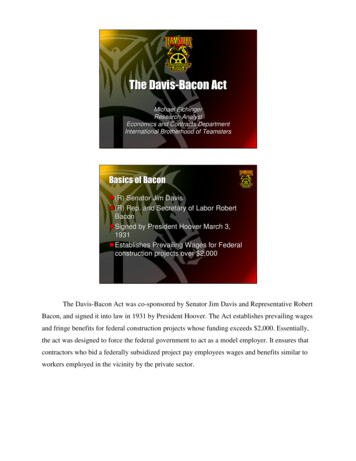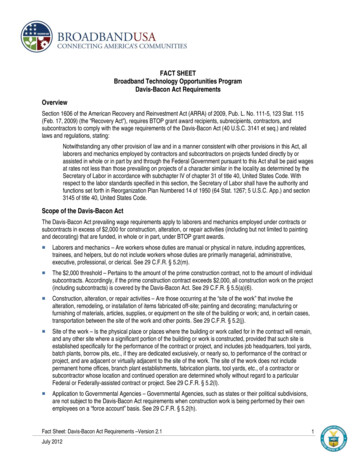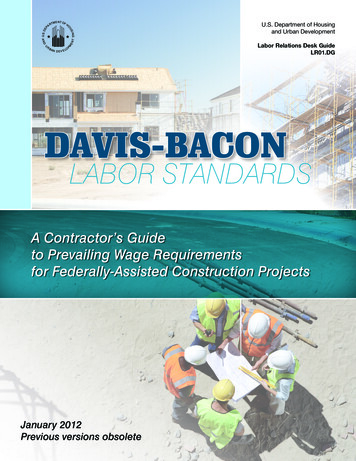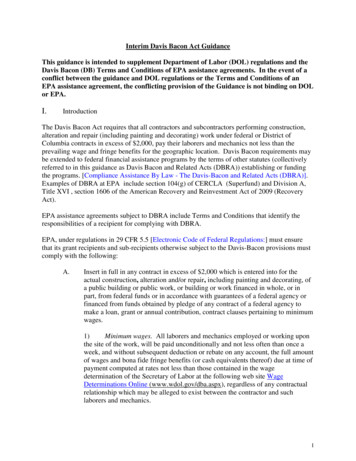
Transcription
The Davis-Bacon ActMichael ElchingerResearch AnalystEconomics and Contracts DepartmentInternational Brotherhood of TeamstersBasics of Bacon (R) Senator Jim Davis (R) Rep. and Secretary of Labor RobertBacon Signed by President Hoover March 3,1931 Establishes Prevailing Wages for Federalconstruction projects over 2,000The Davis-Bacon Act was co-sponsored by Senator Jim Davis and Representative RobertBacon, and signed it into law in 1931 by President Hoover. The Act establishes prevailing wagesand fringe benefits for federal construction projects whose funding exceeds 2,000. Essentially,the act was designed to force the federal government to act as a model employer. It ensures thatcontractors who bid a federally subsidized project pay employees wages and benefits similar toworkers employed in the vicinity by the private sector.
How Are Prevailing Wages Determined? Statewide Surveys WDWD-10 Forms Arranged by state, county, constructiontype, and job classification Construction types: Building, Heavy,Highway and Residential Three states at a timeThe Wage and Hour Division of the Department of Labor first determines theseprevailing wages by conducting a statewide survey. Regional Wage and Hour offices across thecountry send out WD-10 Forms to unions and contractors in the jurisdiction of the survey, andcompile a listing of decisions based on their responses. Prevailing wages are then arranged bystate, county, construction type and individual job classification. The four different types ofconstruction are Building, Heavy, Highway, and Residential. Typically, surveys are conductedon three states at a time, and are a fairly lengthy undertaking. This means that a wage decisionfor a given state may stand for five to ten years. In some cases, wage decisions have been knownto flirt with the minimum wage since surveys are so old.Prevailing Wage Calculations Union’Union’s rate prevails if it represents over50% of workers in classification If 50% of workers in classification receivethe same nonnon-union rate Weighted averageThe wages contained in the decisions are calculated three ways. First, if responses to thesurvey reveal that a union represents over 50% of the workers in a particular state, county,
construction type and job classification, the union’s wage will prevail. Second, if no unionprevails, and there is one wage rate that is modal – that is, 50% of the workers are paid the samerate, that rate will prevail. Third, if there is no modal wage rate, a weighted average is taken ofall responses.Update of UnionUnion-Prevailing Wages Where a union prevails, the rate can beupdated in between surveys Require signed copy of contract with twoor more signatory employers Same as contract used for surveyresponseWhereas, a survey rate cannot be changed in between surveys, if a union’s wage prevails,the rate can be updated without the need of a survey. For a rate to be updated, a signed copy of acollective bargaining agreement between a union and two or more employers must be sent in tothe Department of Labor. The contract must also correspond to the one used to respond to theWD-10 Form from the survey. In other words, the contract you send in for the survey must bethe same one you send to me to update the wage decisions.New Surveys Surveys reset all wage decisions Remember: union prevails at 50 % 30% Rule (before 1982)
If a union has a prevailing wage, and a survey comes up for that state, there is noguarantee that the union’s rate will prevail under the new survey. A survey will supersede anyunion rate that had previously prevailed provided union presence is not greater than 50% of thework present in that state, county and job classification. In the past, there only had to be a 30%union presence for our rates to prevail. This change (made in 1982) makes it that much moreimportant for us to be alert and proactive about getting our rates into the Department of Labor.So, how does this affect you? Survey ContractsSo, where do you come in? You can have an impact on your prevailing wages in twoways: by participating fully with the survey process, and by submitting your contracts andupdated rates to the International.Participation in Survey Response to WDWD-10 Form can includeMLA’MLA’s or PLA’PLA’s PLAPLA-prevailed rates can’can’t be updated Send me the same contracts you send infor the survey State survey schedule available on DOLwebsite The better you comply, the more likely youwill prevail
Since the Regional DOL offices will take any wage rate information during a survey, youshould send in Master agreements, and/or Project Labor Agreements. If the survey finds that weprevail through a PLA, that just means it can’t be updated unless a subsequent PLA withmatching classifications and jurisdiction comes through. But, better to have your rate prevail andnot be updated until the next survey then to have the survey rate. So send in all you have. As Imentioned before, the contracts you send in to the Regional Wage and Hour offices through thesurvey will have to be used when updating rates at the DOL. You can view the DOL’s surveyschedule and results by visiting the Davis-Bacon webpage on www.teamster.org under theBuilding Material and Construction Trades Division webpage. There are many helpful linksincluding one directly to the survey page.Sending in Contracts for Update DOL will not automatically update a wageincrease Send signed copies of MLA’MLA’s that prevailto Construction Division at International Send notice of wage increases andallocation between wages and fringes (ifapplicable) to Construction DivisionSince we are able to update our prevailing wages throughout the life of the contract, it isour responsibility to provide the DOL with these increases. The analysts at the DOL do not takeit upon themselves to automatically update the rates. I have to send them in. So, I am asking thatlocal unions send current copies of all contracts that prevail under Davis-Bacon to theConstruction Division at the International. Once I have your contracts I can alert the DOL of thecontract’s ratification or in advance of any wage increases to ensure that they are included in anyupcoming projects or additions.If the allocation of your increases is to be negotiated on an annual basis, I have to beaware of how they are divided between wages and fringes in order to submit them to the DOL.Some of you are very good about sending in updates to the IBT when these are negotiated, oreven just sending a one-page reminder of an upcoming increase. There is a tremendous amount
of information out there for me to sift through, and I need all the help I can get. If I don’t get acopy of a new or renegotiated contract, I have no way of knowing when to alert the DOL. Theresult is that in places where we are lucky enough to have union rates prevail, they are sometimesoutdated and in many cases by a number of years and by as many dollars. You should also knowthat if rates are outdated and a contractor bids a project with them, there is no legal obligation forthe employer to pay any higher than the prevailing wages posted during bidding. In essence, anyrate over a year old must be updated if an increase exists.Outdated Rates Could be outdated if PLA prevailed Contract no longer in effect Only one signatory companyThere are several currently prevailing wages that are well over a year old. If, afterchecking your rate, you find that it is outdated, this could be for several reasons. As I mentionedearlier, if a union rate prevails by submitting a PLA, there will be no rate to update in subsequentyears. Also, if a contract is no longer in effect a rate may be more than a year old. Finally, if onlyone company is signatory to a contract, the DOL will not update it. Also, just because your rateprevails, that doesn’t mean that you are guaranteed the work for that classification. If, however,you become aware that a contractor is hiring work for that classification below your prevailedrate, a complaint can be filed at the local wage and hour office for conformance issues.
www.wdol.govIf you would like to know exactly where your union stands on a particular wage decision,the most accurate and up-to-date method is to visit www.wdol.gov. From this site you can searchfor decisions by state and county, by decision number, and by the construction type.Unfortunately, there is no way to search by union decisions at the moment – though the DOL isplanning to do so in the future.www.wdol.gov Click on “Selecting DBA WDs”WDs”The process for selecting wage decisions is fairly straight-forward. Once you openwebsite you will select a link beneath the Davis-Bacon Act heading that says “Selecting DBAWD’s.”
www.wdol.gov Select your search criteriaThis will take you to the search page. If you know the decision number already, it iseasiest to enter it in the top portion of the search screen, which will take you directly to thedesired decision. If you don’t have the decision number, you can select the construction type andthe state and county in which the work is or will be done and pull up the resulting decision.www.wdol.gov Here you can browse through different decisions byconstruction typeClicking “Search” will reveal a listing of decisions to choose from. The more informationyou enter, the fewer results you will have to search through.
The Wage DecisionDecisionNumber Top of Wage DecisionOnce you click on the applicable decision number, it will bring up the actual text of thedecision. The very top of the decision contains identifying information. These include theDecision Number, State, County and Construction Type. It also has a listing of modificationsthat have been made to the decision along with their dates; as well as the full identifier code ofthe superseded decision in case your records show a different code. From here, you scroll downthe page through an alphabetical listing of unions or surveys.The Wage Decision Teamster Prevailing WageThe code used for the Teamsters is TEAM and then the local union number behind it.Next to this you’ll find the date of the most recent modification. In this case, you can see this isthe decision for local 470, and was updated in May of 2007. Below this you’ll see a listing ofclassifications with corresponding wages and fringe benefits. Fringe benefits constitute any
benefit that is offered by the employer that’s not required by law, such as education, training,pension etc. These are expressed in per hour terms except where there needs further explanation,in which case footnotes are added (in this case A B which have been cut off) but these mayinclude a listing of holidays or paid vacation.If there are many classifications with the same wage rate, the DOL may lump themtogether by “Groups” and provide a listing below of the specific classifications. If you see thatyour wages are outdated, or you recognize an upcoming increase that will need to be updated,send in a notice of the increase and a copy of the signed contract to the Construction Division atthe International, and I can make sure the DOL updates your rates. Again, your help insubmitting contracts can make all the difference in the world.Thank youMichael Check the DavisDavis-Bacon link on theConstruction Division’Division’s website foradditional resources
Basics of Bacon (R) Senator Jim Davis (R) Rep. and Secretary of Labor Robert Bacon Signed by President Hoover March 3, 1931 Establishes Prevailing Wages for Federal construction projects over 2,000 The Davis-Bacon Act was co-sponsored by Senator Jim Davis and Representative Robert Bacon, and signed it into law in 1931 by President Hoover.










